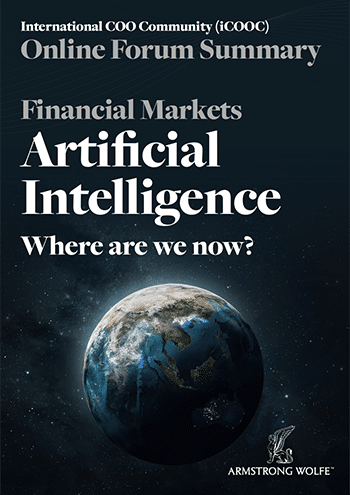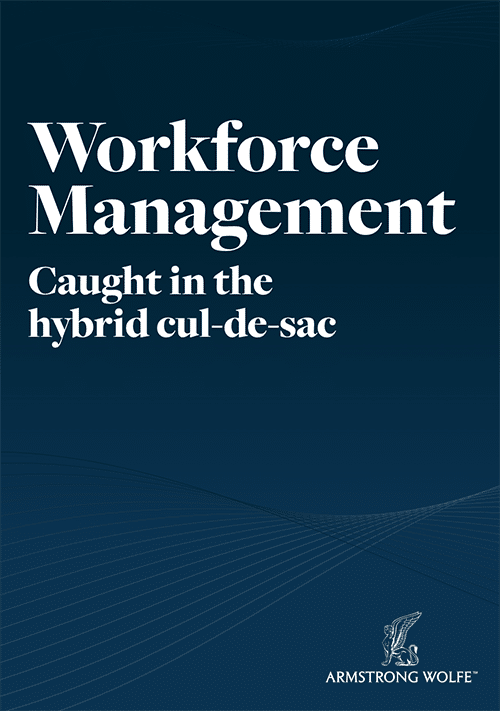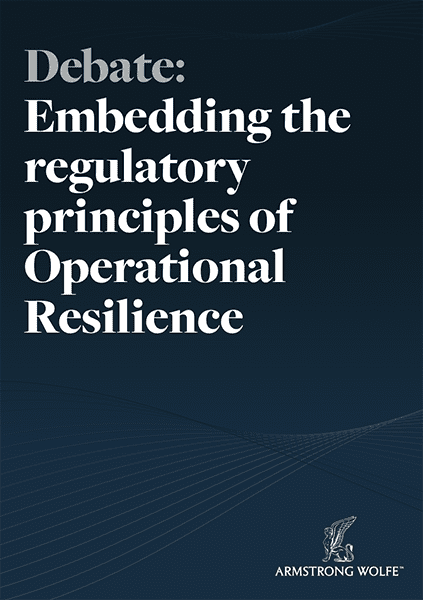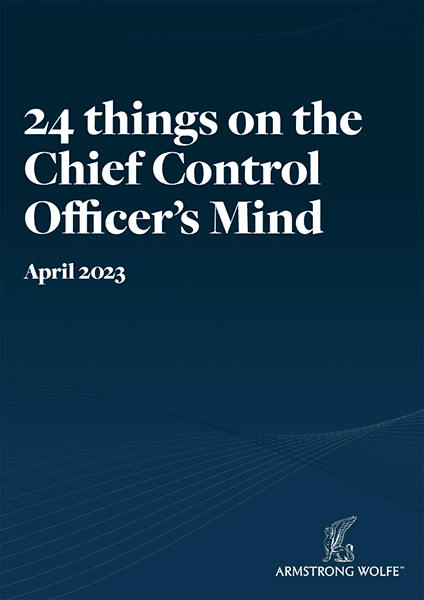“The interrelationship of the CEO and the COO is essential to the success of the business.”
PLAYING SECOND FIDDLE
The mandate and profile of the front office business manager
Executive summary
The evolving role of the COO – how its mandate is defined, its tasks allocated and executed, and the nature of its growing internal and external accountability – is a subject of debate across the banking community. Historically, the role was tied to a business and not necessarily a person. Invariably the COO stayed in place, providing continuity for a business as leaders were anointed and then lost their crowns. While this has changed with time, today some COOs still prefer to be the power behind the throne – the consigliere, if you will – while others embrace the opportunity to step into the limelight that the evolution of the role has offered.
Changing demands in the market have forced banks to look at this important and well-paid resource, delivering a change in the mandate and empowerment of the COO. The need for enhanced communication and greater accountability, as well as a continued demand for cost reduction and coordination of the control and regulatory agenda, has led most banks to centralise the business management function, be it within the business itself or into finance. This is no simple undertaking, as organisational, business, regional and personality nuances have left the industry with a single reference point for this role: the title ‘COO’ itself. Many argue that this title is overused, misunderstood and diluted.
The move to a centralised COO (business management) organisational structure is one many believe in, and it lies at the heart of this discussion. It may appear that we gloss over the current debate regarding the complexities of pay (or overpay) within banking, which in the case of the business management structure is further complicated by matrix managerial structures and the sometimes unfathomable and inconsistent allocation of financial reward. However, we have assumed here that within the business management function, the issue of cost can be resolved and savings realised for the shareholder by avoiding overstaffing and overpayment in administrative roles such as junior COO, business manager and support staff. Such roles can be overpaid when funded from the front-office compensation pool, when this headcount could be moved into the infrastructure or, as this essay argues, moved into a centralised pool where performance and reward can be evaluated objectively. We do not seek to interrogate the compensation agenda, but refer to it only in context of the question under consideration – defining the role of the COO.
However, there is one argument regarding business management compensation, supported by many COOs, that is worthy of note here. Since investment banking as an industry has hit a plateau – or even shrunk – as both ability and appetite for generating new derivative products has declined, the value-add of certain internal banking functions needs to change. Some argue that low- and mid-level front-office staff are joining established global banks with existing customer bases and should not receive inflated compensation relative to other industries. A comparison might be a junior lawyer joining a top ten law firm, a trainee accountant at a top four firm or an associate at a leading consulting firm. All these industries compete for the best talent and do not use compensation as a primary recruitment tool. The best people are enticed by future opportunities and a well-trodden path to seniority or partnership.
Conversely, it is possible to contend that it is the COOs who are now adding long-term value in banking by creating and establishing new workflows, which adapt to new regulations in a cost-effective way. Some would state with confidence that the experienced and proven COOs who get this right for their firm are worth significantly more than a global asset franchise trading head whose mainstay is one-year-at-a-time client revenue generation. This matter will always be an emotional and personal one, especially when change is proposed, and opinions surrounding it are not always linked objectively to the benefit of the company.
More recently, compensation has been married to control through the conduct agenda. In this regard, it is possible to argue that the benefits of mobility and consistency outweigh the loss of management control by business heads; there appears to be no substance to the argument that a central COO function cannot retain a close business alignment when not owned by the business. Equally, this alignment delivers a degree of objectivity and independence to the relationship. Regardless, it is rare for a business manager to be drawn cross-product, although it is common for people to think in this way. This may be good for the company, but it is irritating to a business that wants to maintain a silo mentality. Some companies have both a central team and a business team, and the passage of time has shown that sometimes this works and sometimes it does not.
It is my contention that the banking industry has created confusion and a problem of individual empowerment through the dilution of the title ‘COO’. We can contextualise this by a loose comparison with the same role in other industries. Outside banking, most corporates have a single COO, and all employees know this is an executive role that carries significant weight. In contrast, most banks have dozens – sometimes hundreds – of COOs. Why? This may be a throwback to the heady days of growth and profitability, a historic extension of the ego of the business heads (‘I have a COO’) rather than reflecting a genuine need to empower the role through the connotations imbued within the title, chief operating officer. It has even been suggested that banks have used it as emotional compensation – promotion by title, not by mandate. Some banks are addressing this, replacing the title of CAO or COO with ‘business manager’, but even here ‘COO’ continues to be used in general parlance and along the corridors of investment banks. In fact, the list of responsibilities outlined for a COO supports the migration of the title to CAO, whereas in most non-banking companies many front-office banking COO responsibilities would fall within a CAO or CFO role. For example:
• Working with the head of the business to set and drive product/divisional strategy: COO (or Head of Strategy where one exists).
• Coordinating and driving the product business managers/ COOs under management towards business objectives: COO (responsible for the execution of the strategy).
• The control, conduct and governance agenda (front to back): COO (or Chief Control Officer).
• Coordinating the support functions and management of the front-to-back business line and offering: COO (a portfolio of work more aligned to a CAO).
• Reporting on and monitoring the use of the business’s weighted risk assets and external assets and managing its ‘financial capital’: CFO.
• Reviewing and managing the capital of all subsidiaries within the sphere of the business: CFO.
• Setting and managing budgets for the business: CFO.
• Collective responsibility for capital management, including profit repatriation, capital hedging and the closure of dormant subsidiaries and legal entity restructuring to establish more efficient capital utilisation and business management: CFO.
• Collective responsibility for driving effective capital management throughout the organisation, establishing guidelines and budgets with the business for balance-sheet usage, and monitoring adherence to those guidelines and budgets: CFO.
• Managing transformation and change within the business and its support functions: COO (CAO core tasking).
• Responsibility for staffing and talent management: HR
“The interrelationship of the CEO and the COO is essential to the success of the business.”
In brighter times, this list would have included developing new products, opening new markets, starting new businesses, etc. These lie at the heart of any true COO’s responsibility to drive revenues. However, today these more positive aspects have been replaced by setting up governance and control frameworks and responding to ongoing regulatory demands, pulling the COO into a CAO’s framework of tasks.
It is possible to review the weighting of the COO’s book of work at any time and state that the person is now operating as a CAO or a de facto CFO. As this book of work is inevitably cyclical, being linked to the calendar year and/or based on the demands thrown at it externally by the market or internally by strategic or operational change, the COO might, at any given point of the year, wear a hat that could equally be worn by a CAO, CRO, CFO, and so on.
“It is inevitable that the COO role and mandate will further evolve and change, and as it does the profile of those that aspire to hold its crown will change simultaneously.”
GLOBAL HEAD OF FRONT-OFFICE HUMAN RESOURCES, INVESTMENT BANKING, NEW YORK
The point here is that the role of the COO is dynamic and subject to change. This change can be driven by the industry, by regional differences, by executive personalities or by merger. The influences are numerous. One thing is for sure – the type of person who pursues this career path and the type of person that banks hire must be adaptable to survive. The requirements of the industry are changing at an unprecedented rate, so the people charged with leading it must be flexible.
Alignment: integrated or non-integrated; centralised or non centralised
Almost without exception, the main wholesale banks (with a markets focus) started this process of change by centralising the business management function. Some banks already had this operating model in place, but governance models within these institutions habitually demonstrated inconsistencies by product and region and struggled to maximise the efficiency of such a configuration. This was perhaps compounded by the banking industry favouring the ‘healthy tension’ inherent in matrix management structures. In some cases, where a matrix structure existed, this led to misinterpretation of or non-compliance with the spirit of the operating model and to a lack of cohesion.
These early models, however, did establish a pre-regulatory era precedent and demonstrated (and to a large part validated) the model and potential benefits that could be realised by such an organisational shift. The appointment of a global COO for markets was a natural conclusion to the implementation of this management model.
On the other hand, where banks had a non-integrated and/or decentralised business management function, with the business owning this headcount, some banks had (and still have) no appointed executive COO for global markets with a clear mandate of authority. In this model, the global markets’ COO struggles to secure support, as no definable or obvious mandate of tenure exists in a decentralised alignment. In addition, this came about in an era when front-office COOs still sought support for their role across the bank, an understanding of their value and justification for weighty compensation. In limited examples where such an appointment did exist, it was one of influence – ambassadorial in nature, rather than possessing a quantifiable, accountable and justifiable mandate.
As this debate progressed, embedded COOs fought against the change, believing that the centralisation of the business management function would dilute their independent mandate, reduce their influence and almost certainly lead to a reduction of their compensation. COOs have expressed such concerns in the following ways
“Where I would have enjoyed autonomy, working directly to and at the beck and call of my business head, I would now report up into business management function, ultimately to an executive COO of product (global COO fixed 62 income or equities) or region (markets’ COO Americas, Europe, MENA or Asia) or division (markets). This change, I would argue, restricts my movement and ability to make decisions quickly. This alignment would thwart the effort to move the agenda forward unheeded for business units.”
MD EMEA COO, CREDIT PRODUCTS SALES AND TRADING, LONDON
“I believe strongly that to be wholly directed and owned by the business allows the COO to dedicate 100 per cent of their time to their business effort and tasks. Becoming part of a separate and centralised function, where you would service and support the business, you would invariably direct an increasing amount of your time to tasks that were cross-product or division-wide.”
DIRECTOR, COO RATES TRADING, NEW YORK
“There is a perception, a deep-rooted concern, that individual compensation, and especially the variable component, is better managed when allocated directly from the business, as opposed to a centralised bonus pool for the business management function as a whole. 63 In the decentralised model, the COO’s pay is linked to the performance of the business line they support, where the only person that has an informed insight into the value their COO adds is the business head themselves.”
MD, GLOBAL COO FX, LONDON
One issue that has arisen over time is a lack of career mobility for COOs. Many rely on the patronage of their business sponsor and are vulnerable if this sponsor changes role, whether internally or externally. It is not unusual in the few banks that retain a decentralised model to find COOs who have been in the same seat for many years and/or whose careers have mirrored the progress of their patron (their business head) as they have successfully navigated their careers upwards, often taking their reliable COO with them. This could be seen as riding the coat-tails of success or conversely as an effective partnership that has realised success.
What is missing when viewing COO career advancement through this lens is the important consideration of the depth and seniority of the COO team and how this can enhance or limit career opportunities. For example, a team consisting of a few graduates and an even distribution of headcount through to managing director would create opportunities for career management, promotion and mobility over time. Alternatively, a team weighted towards experience (vice president through to managing director), which marries to the body of work better, poses career and promotional challenges. The latter model leads many to wonder where they might go next, as they wait for opportunities to unfold above them within an ageing and shrinking market.
A corporate view – one increasingly recognised by executive management and guided by in-business human resource partners – is that this lack of mobility is not good for the individual. In particular, it limits career opportunities for junior business managers, who end up being blocked from promotion by a glass ceiling of established management. Indeed, even if these stalwart and embedded cornerstones of their respective businesses wanted to move externally, many would find it difficult, as longevity of service and experience limited to one bank are not compelling offerings as far as many senior hiring managers are concerned. By the same token, thwarting the in-business promotion of emerging talent, especially those who have received significant investment in their development by their employer, risks this asset defecting to competitors who are looking for well-practised business managers. Additionally, as control and risk are now resident at the top of the corporate agenda, relying on one person who knows the business inside and out – who has become part of its DNA – carries risks and well as benefits.
An understanding of these factors and an appreciation of the benefits that can be realised from integrating the business management function, have led the majority of the market to move towards a fully integrated and centralised function, delivering many advantages:
1. The necessity of meeting the demands of the control and conduct agenda is better served when this agenda can be expedited through a business management function that is ultimately owned by one executive manager, backed by a board mandate to drive this effort. This has invariably seen the appointment of a markets’ or division-wide control officer, charged with defining the operating model for the division and then working with the principal COOs (global COO of fixed income or equities) to implement this 65 strategy. Organisationally speaking, the control officer is a peer and, almost without exception, previously a COO and/or business head, bringing appropriate knowledge and experience to this appointment. A debate continues as to whether the control officer should sit alongside the COO at all levels in a position of equality and independence or whether the control officer should report to the COO. Currently the latter prevails; the global markets’ COO retains responsibility for the control and conduct agenda, while the business heads have accountability for control itself.
2. The business management budget and associated costs are better managed when centralised, enabling the total loaded cost to be attributed, managed and quantified. Centralisation also enables cost efficiencies to be realised as, for example, transformation and change resources have greater visibility and can be allocated more efficiently to project demands division-wide.
3. Compensation structures can also be introduced division-wide, enabling both internal benchmarking (against other COOs as well as senior infrastructure management roles) and external market comparisons. This depends heavily on the collaboration of senior management, enabling calibration of compensation across functional titles, regardless of reporting lines or degree of centralisation. It also allows the bank to reward business managers in line with their individual performance, weighted against their COO peers, as opposed to the performance of the business line. A consequence of this is the ability to move business managers more easily from one product to another without facing the issue of disparate and inconsistent rewards. It does not necessarily manifest itself as a reduction in reward (see below), but puts in place a framework in which the business can manage this sizeable team more effectively.
4. Career mobility is enhanced in the centralised model, which views business management as the principal skill-set and is product agnostic. The bank can create a function that has breadth and depth and reduces reliance on the individual, while simultaneously enhancing the individual’s commoditised value by diversifying that person’s experience. Some see this as a sliding scale: junior COOs typically work on asset class-specific issues regardless of structure; senior COOs learn the sub-product of an asset class and are expected to apply principles broadly when designing solutions.
What has come out of this organisational shift and the impact of regulatory change is a review of the role and its desired influence and mandate. The profile of the person that occupies the role of COO is changing in line with this evolutionary process. What a bank wants its COO community to do, and what the individual is mandated and accountable for, will now define the competencies of the COO. However, while most banks retain the title ‘COO’, an investigation of COO responsibilities and position in each bank reveals that two mandates are now in place, and many COOs are in reality operating as CAOs.
The Chief Administration Officer
The CAO is an appointment focused on supporting and facilitating the business internally (see below), and managing the front to back and the control agenda are now the principal tasks of the CAO. There is an industry push to ensure that all reporting – previously resident on the business manager’s task list – is issued by the infrastructure most logically accountable for it: finance for capital balance sheet, P&L data, etc.; HR for headcount; and so on. In reality the business manager will get these functions to deliver information and then validate its quality with intimate knowledge of the failings of each function.
The COO needs to walk a fine line between facing off to the infrastructure functions and owning and driving them. This is where the role falls between the COO and the CAO. Many COOs believe that the shortcomings of the infrastructure distract them from their main effort, but they must be careful not ‘to shoot the messenger’. For example, finance may seem incapable of performing a computation properly (system limitation/time frame, etc.), but the COO cannot always take up the slack or seek to remedy the issue in a structural manner. Many business managers find this the hardest part of their job – influencing the infrastructure function to improve itself. COOs must demand, influence and be accountable for this improvement, but they cannot execute it. They must also seek to continuously identify the next value-added element in need of improvement.
One consequence of the heavy hand of the regulator is to homogenise how divisions and businesses are run and to implement a closer relationship between COOs and their infrastructure partners. To explain this in the concrete rather than the abstract, the same reporting on approximately the same data is being produced in all the G20 banks. Over time, the emphasis on conduct topics grew, while previously EU banks had placed greater emphasis on RWA (American banks needed to catch up on RWA topics due to the reluctance of their regulator to fully implement Basel 3). This shift demands a greater level of cooperation front to back, as the cost and accountability challenges are increasingly aligned to the business’s activity within its full cycle, not just the point of sale or trade. Where does this standardisation leave responsibilities in the context of the CAO?
• They are required to deliver cost reductions of a magnitude never seen before. If such volatility in markets remains, this will be important for large platforms and vital for smaller ones, where the cost of a ticket to print is marginally higher.
• They must drive the infrastructure on behalf of the business head. This is creating a Hegelian master-slave dialectic, as the head of the business is accountable to regulators and shareholders but cannot afford to spend time on all topics and drive risk and revenues.
• There is a need to harness the infrastructure to create relevant client/market intelligence to help drive risk-adjusted revenue.
“The industry’s CEOs and business heads own this evolutionary phase of individual company and industry-wide change, but their COOs own its execution and share its accountability. To be successful they must possess the qualities essential to promote a positive image, to be committed and passionate, energetic with an engaging manner and a strong communicator with executive presence.”
MD, GLOBAL COO EQUITIES, LONDON
The Chief Operating Officer
Historically, many companies outside the Financial Services industry operated without a COO. Before the credit crunch began in 2007, more than 60 per cent of Fortune 500 companies did not have a COO. Since the global recession, however, this percentage has dropped significantly, as companies both within and beyond Financial Services began to see the advantage of having executive succession planning and shared accountability in place (to and with the CEO), as well as having top-tier executive leadership overseeing all operations. In such cases, the COO wears the mantle of a de facto CEO and must thus be of an appropriate calibre – above that of the traditional operational COO. Their competency enables the CEO to focus more fully on business strategy and the increasing burden of internal and external ambassadorial responsibilities. This mantle of being the CEO-in-waiting may be relevant outside banking, but it is not within it; there COOs are not appointed based on their potential to become the CEO but on their ability to manage the complex matters at hand within an increasingly regulated and demanding sector (see ‘The Banking COO vs the non-banking COO’, p. 113).
With the recession and the consequent demands by shareholders for enhanced control and risk management, banking is not the only industry to experience a resurgence in the number of COOs (although within banking this evolution is wedded to what many call the ‘regulatory era’). There are good reasons, therefore, to anticipate an increased utilisation of the COO position in the future, moving its role from that of COO in title but CAO in reality to becoming an empowered partner of the CEO – a deputy CEO in all but name, with an executive mandate. The reasons for this are as follows:
• Generally, companies are becoming more global, larger and more complex, making it difficult for one person alone to have total oversight over the whole organisation.
• Companies are finding a strong relationship between strong performance and the presence of an executive COO charged with driving the business, not just supporting it.
• Companies are becoming more deliberate about CEO succession planning and could feasibly and justifiably use the COO role to train successors and develop rising talent to move from within the business into a COO role and back into the business as part of their executive development.
• The increase in talent mobility means that the role will probably be used more often as a retention mechanism for key executives at risk of moving to a competitor.
• Regulatory change in banking is mostly driven by regional bodies, which demand a high level of local executive ownership.
These principles are notably focused on the interaction and positioning of the CEO and the COO. Nevertheless – and uniquely within banking, where the COO title is awarded across many levels, regions and products – the spirit of these conclusions can be applied to the relationship between any business heads and their COO, at any level. The principles of selecting COOs and defining their mandate can therefore be applied to any rank, from local product COO or business manager at VP level, through to a regional COO at director to managing director level, or even global-level COO as a seasoned managing director.
“The relationship between the Chief Executive Officer and the Chief Operating Officer in any (global non-banking) organisation is fraught with many psychological complexities. Perhaps it is the most difficult of all organisational working relationships because, more than others, it is a balancing act on the threshold of power.”
HARRY LEVINSON, PSYCHOLOGIST AND CONSULTANT
However, this evolution carries risks. The interrelationship of the CEO (read ‘business head’) and COO is essential to the success of the business and goes hand in hand with a fully integrated and centralised operating model. To be effective, there must be a union between two strong and independent personalities who understand that they must work together in the interests of the business, its employees, clients and investors. This heightened performance and accord can only be realised where self-interest has no foothold. Within most commercial sectors, a self-effacing personality is a rare commodity, and this is perhaps even more true of the Financial Services industry, which has a reputation for attracting and tolerating those with a heightened opinion of their self-worth.
The selection and appointment of the COO must therefore rely strongly on an analysis of character; the COOs must marry well with the CEOs and vice versa. Between the two there must exist an understanding, a sense of respect, even an enjoyment of this partnership. Any lines of difference must be complementary, becoming lines of collaboration and not conflict. This qualitative assessment is central to the selection process. It works best when those known well to the CEO and who hold their ear can advise candidly on the selection of the COO to make this critical relationship work. In this case, CEOs may have to show sufficient humility to accept their own opinion being overridden.
Why is this relationship so important? Any breakdown in trust between the CEO and COO can lead to failure. The COO typically has to be a high-level leader who is comfortable being fully in charge. Many executives with the leadership skills necessary to be a top-level COO would prefer to run their own organisation or business line than take orders from a CEO and not directly contribute revenues. COOs who are expecting to serve their time and be promoted to a higher position may have a different timeline in mind for this movement than the CEO, causing a breakdown in the relationship. COOs can also find themselves being labelled an ‘operations’ person or a ‘Number 2’ rather than being seen as a strategic and high-level leader by the board of directors, which causes some executives to steer clear of the position.
This is especially the case in investment banking. Appointing a COO as the de facto deputy to the head of business marks a seismic shift – one that requires capital investment and an adjustment upwards in compensation. Few revenue contributors are enthusiastic about being moved into non-direct revenue generating roles for an interim period, even if they understand that this is part of their career development and especially if short-term annual compensation is significantly and negatively impacted. The overall cost could also be a loss of revenues, as a business line loses its leader and has to adjust accordingly. However, the benefit of having a more skilled leadership team should make up for this loss over time.
“You can respect a technical leader at business level that delivers revenues, but would you follow him or her, are you inspired by them? There is a clear difference in securing promotion through the traditional producer-manager model (through revenue contribution), as opposed to someone that secures promotion due to their inherent and proven leadership skills. The success of a COO in the future will rely on the traditional characteristics of leadership: impact and articulation; communication and direction; ambition; intellect; energy and inspiration; 74 values; innovation; subordinate development; delegation and mobilisation, self-awareness and empathy married to strength of character and conviction.”
EMEA GROUP COO, EUROPEAN WHOLESALE BANK
It is a shift that will favour the brave, as they in turn embrace the demand to change the future profile of leadership and make tomorrow’s executive leaders more rounded. They are also better-equipped and possess an in-depth understanding of the business front to back, the control and conduct agenda, and cost management. And they are able to define an innovative strategy, drive the business forward and remain competitive. All of this, of course, being linked to the growing burden of intrusive reviews and regulated executive accountability.
It is inevitable that the COO role and mandate will further evolve, and as it does – where bank-to-bank variances exist – the profile of those who aspire to it will change simultaneously. Some who have never considered such a position as part of their career path, and for whom a move from revenue creation to revenue support is anathema, will face this decision in the future. There will also be those who recognise that such a move would be prudent in order to maximise the chances of long-term career success. Regulators may soon demand it, and certainly many banks are likely to encourage a select few of its future leaders to make the move. However, not all will achieve success, accomplished as they may be in generating revenues and as consummate as they may be from a technical perspective. An ability to lead, instil confidence and motivate will be a fundamental requirement for success in this significantly changed, evolving and high-profile role.
It will be significant if any executive board embraces this opportunity and recognises the COO role for what it has truly become in the modern era. Decisions about who should be appointed a COO, at all levels, and how to establish a broad and deep talent pool of well-rounded and appropriately trained and educated leaders to take the business forward in the next generation will become increasingly important. Within this context, the COO role itself will come under more intense scrutiny, and many of those currently operating as CAOs to all intents and purposes may be able to step into role as truly empowered and accountable COOs.
A braver step still would be to appoint business heads who do not come from a revenue-generating background, perhaps having come up through the business management function itself. The head of the business, after all, does not have to be the highest earner in that business; the person must simply be capable of managing it effectively to meet or exceed its annual and mid- to long-term objectives, of which the key one is total revenues. One can almost hear the ‘tut tut, nonsense’ dismissal of business heads at this suggestion, but what proof is there that a business head, with outstanding management and leadership skills and a technical understanding of the business, could not lead a business and its sales and trading team?
So, what is really needed to be an effective COO in the modern world – beyond the traditional qualities outlined above? Certainly an effective EQ (and PQ for that matter) is one new skill required:
“It’s harder to abuse someone and tell them to do it or they are sacked; this works on occasion, but in order to land cultural change, it needs a different style. This is polarising the population as it’s simply a harder thing to teach and do. It’s a generational matter, where some will embrace this challenge and some will simply be unwilling 76 or incapable of doing so.”
GLOBAL COO, REGIONS
What appears to be missing within the COO community as a whole is physiological resilience. Many have only known good times, organically created their own world, had limited people to answer to and been paid handsomely. Often this was entirely fair – there were, and are, a lot of capable and driven people within this community, doing great things. However, until recently they have been penalised through a marginal reduction in compensation – in 2016, 10–20 per cent of bonus against a high starting point – as there has been no real recalibration of the function or right sizing. Evidence suggests this is beginning to change, with the centralisation and greater development of the COO role. Some are undoubtedly reflecting on the demands of the role in a more pressurised era which, in addition to the reduced financial reward and apparently limited career options, makes the COO role less attractive, or at least one for those possessing physiological resilience:
“This era of change within the industry is not for the faint-hearted. It will need robust and charismatic leaders to execute it. Charisma is needed to take the business management community, and indeed the industry as a whole, through trying times ahead. They will experience uncertainty, greater levels of accountability and, I anticipate, reduced compensation.”
FORMER COO
When you add limited career opportunities within a shrinking market, it is not possible to look at the changing business management and the role of the COO within it without looking at the changing skills and personality required from leaders of the banking industry to meet the demands of the new era. In the past, the best revenue-generating individuals were often promoted to desk and business heads to encourage them to forge a career path within the company. Promotion was not always based on their managerial skills. This may change as the demands of business leadership change. COOs may succeed in a business-leading role. More likely, future business heads may have to step out of a revenue-generating role into a COO or business management role to gain the experience and skills necessary to lead and manage a business. This shift would be in line with the changing COO mandate. Undoubtedly the COO is at the forefront of this evolution and will continue on a daily basis to encompass the roles and responsibilities needed to run the business, be they linked to administration (as the CAO), financial (as the CFO), risk (as the CRO) or control (as the CCO):
“The industry’s CEOs and business heads own the opportunity and the responsibility to deliver industry-wide change, but it is the COOs who will own its execution and share its accountability.”
PARTNER, FINANCIAL SERVICES PRACTICE, MANAGEMENT CONSULTING COMPANY
One of my contacts, currently the UK COO to a major European banking franchise, added colour and direction to my analysis when summarising his thoughts (outlined below). Such insights have been invaluable in shaping my understanding of the COO role, its ambiguities and points of measurement. This summary is added postscript, as it is helps contextualise some of my findings and assumptions throughout this book:
1. The term COO is undoubtedly an anachronism; there are many of them in a banking organisation. However, so is the term managing director. So we should just accept that banks have historically accepted title-creep and move on. Terminology in this case is probably a distraction.
2. Why COOs seem to be tied to the business head and not to the role… So a new business head often, though not always, means a new COO, revealing the key characteristic as ‘trust’ or even perception by others that the COO knows what the business head thinks – a sort of mind-reading ability developed by COOs due to their close professional relationship with the business head. How true is this, and is this a good or bad sign for the COO?
3. Career-wise, COOs are almost never going to be business heads, as they are usually focused on navigating the jungle of systems, policies, committees and cost reports that the business head needs to represent their interests, but does not have the time to do. In that regard the COO can behave as a body double, speaking on behalf of the business head and complementing that person’s focus and expertise. If the COO achieves this, then his or her compensation is justified.
4. The reality is that in banking, the support and control departments are complex and expensive and can appear opaque to the commercially minded business head. COOs are is charged with focusing their energy on cutting through that complexity, whether intended or not, and getting to the heart of the proposition. Is this process needed? Is it being run in line with industry standards/best practice? Is my business being charged a fair allocation? These are all questions the business head expects the COO to be able to pose and answer.
5. Expertise-wise, COOs have a truly enviable role. They develop interpersonal, industry, process, control, analysis and reporting skills second to none. They deal with some of the brightest people on earth, from many different backgrounds, and are expected to hold their own in discussions with experts. They see the business franchise as an object they are mandated to protect and arguably are the glue that keeps the business and the bank’s support and control functions connected. If they were to choose to change direction into a specific part of the bank, they could not ask for a better vantage point from which to make that decision.
6. From a regulatory perspective, COOs are crucial. Not only will they represent the business head where needed, but they are also among the few people who offer a bird’s-eye view of the shape and direction of travel of the business, as well as being able to articulate the overall effectiveness of the support and control departments.












